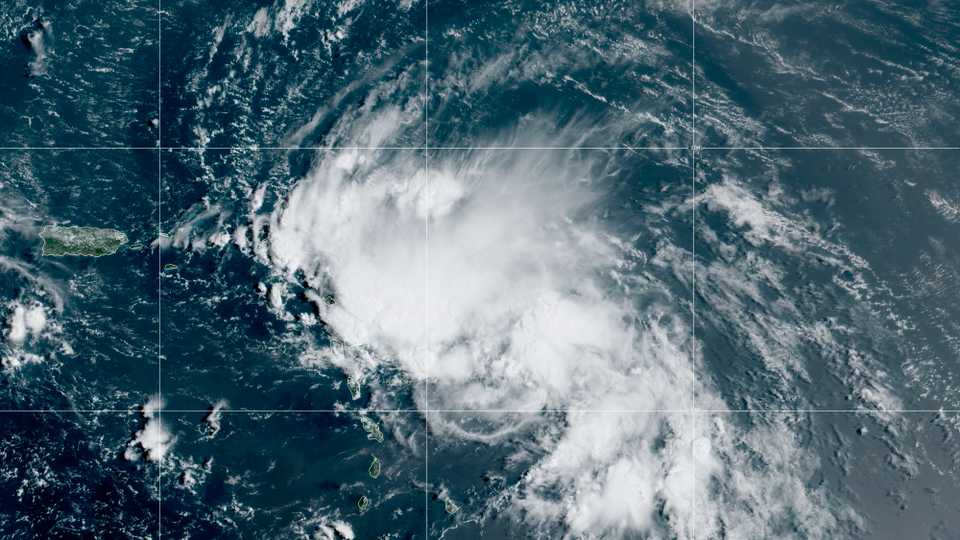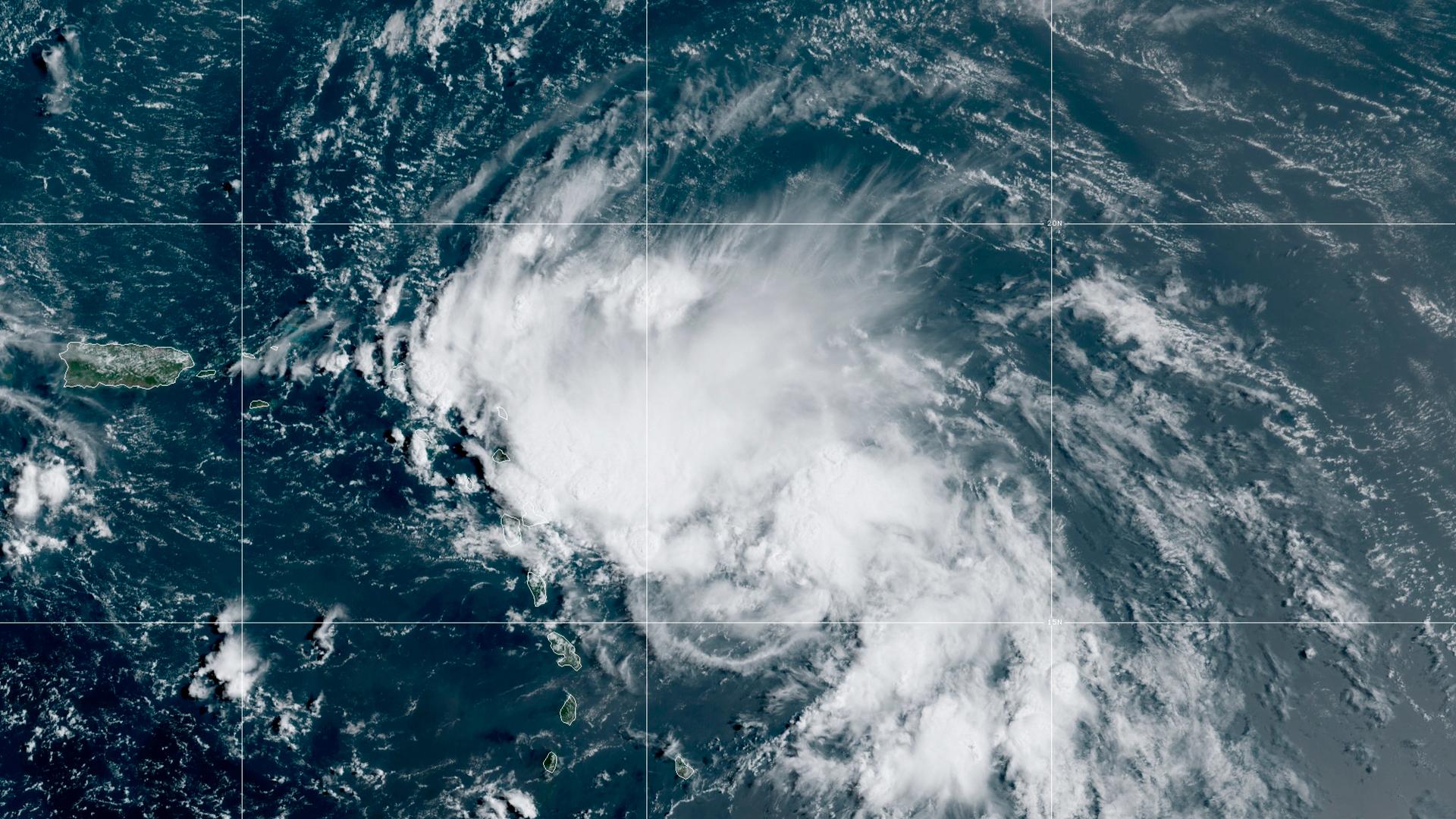
Two tropical storms have advanced across the Caribbean as potentially historic threats to the US Gulf Coast, one dumping rain on Puerto Rico, the Virgin Islands and Hispaniola while the other swept into the gulf through the gap between Mexico’s Yucatan Peninsula and Cuba.
The weather movements were announced on Saturday, as Tropical Storms Laura and Marco were both projected to approach Louisiana’s coast at or close to hurricane force just two days apart in the next several days.
A hurricane watch was issued for the New Orleans metro area, which was pummelled by Hurricane Katrina in August 2005.
READ MORE: Potential hurricane threat to US as twin storms approach
If Tropical Storm Laura looks this impressive on Satellite while struggling with the complex, potentially destructive effects from the mountains of Hispaniola, I believe Laura has significant potential once over the Gulf in an environment favorable for significant strengthening. pic.twitter.com/u8vNAs9R6K
— Jim Bishop (@StormgasmJim) August 23, 2020
Two hurricanes have never appeared in the Gulf of Mexico at the same time, according to records going back to at least 1900, said Colorado State University hurricane researcher Phil Klotzbach.
The last time two tropical storms were in the Gulf together was in 1959, he said.
The projected tracks from the US National Hurricane Center late Saturday pointed to both storms being together in the Gulf of Mexico on Monday, with Marco hitting Louisiana at midday and Laura making landfall in the same general area Wednesday.
But large uncertainties remained for that time span, and forecasts have varied greatly so far for the two storms.
“We are in unprecedented times,” Mississippi Gov. Tate Reeves said at a news conference Saturday as he declared a state of emergency. “We are dealing with not only two potential storms in the next few hours, we are also dealing with Covid-19.”
#Environment – Tropical #storm watch issued for several #Caribbean islands – @JamaicaObserver https://t.co/aAY2EpdMZl
— #PHC-DIGITAL Design (@PH_AEDD) August 23, 2020
He urged residents to prepare for the storms and, if possible, find places to evacuate that are not public shelters.
A hurricane watch was issued for Intracoastal City, Louisiana, eastward to the Mississippi-Alabama border.
People in Louisiana headed to stores to stock up on food, water and other supplies.
Puerto Rico
Laura flung rain across Puerto Rico and the Virgin Islands on Saturday and knocked out water service Saturday night as it whipped at the Dominican Republic and Haiti.
It was predicted to move over Cuba on Sunday on its westward course to the gulf.
In Puerto Rico, the storm knocked down trees in the island’s southern region and left more than 200,000 clients without power and more than 10,000 without water across the US territory.
Officials said they were most concerned about the thousands of people in Puerto Rico who still have been living under blue tarps since 2017′s Hurricane Maria and the hundreds of families living along the island’s southern coast in homes damaged by a string of strong earthquakes this year.
READ MORE: Tens of thousands flee as fires rage across California
#NOLA can’t catch a break in 2020. First was a massive post Mardi Gras #COVID outbreak. Then Tropical Storm #Cristobal hit in June. Now, coming down the pike are #Marco & #Laura!#4WARN @WSMV pic.twitter.com/264yiu9aV6
— Dan Thomas (@WSMVDanThomas) August 23, 2020
Heavy winds
Laura was centered about 40 kilometres southeast of Santo Domingo, Dominican Republic, late Saturday, with maximum sustained winds of 85 km/h. It was moving west-northwest at 26 km/h.
Before the storm began moving over Hispaniola, crews in the Dominican Republic evacuated dozens of families in flood-prone areas.
Marco, meanwhile, was centered about 755 kilometres south-southeast of the mouth of the Mississippi River and was moving to the north-northwest at 20 km/h.
It had maximum sustained winds of 100 km/h and could become a hurricane sometime Sunday.
Gulf of Mexico
Carlos Joaquin Gonzalez, governor of Mexico’s Quintana Roo state, celebrated that Marco’s changed trajectory spared his state’s beaches, including those in Cancun, the country’s top tourist destination.
The National Hurricane Center said it expected the storms to stay far enough apart to prevent direct interaction as the region braces for the peak of the Atlantic hurricane season, which is forecast to be unusually active.
Both storms were expected to bring 8 to 15 centimetres of rain to areas they were passing over or near, threatening widespread flooding across a vast region.
“A lot of people are going to be impacted by rainfall and storm surge in the Gulf of Mexico,” said Joel Cline, the tropical program coordinator for the National Weather Service. “Since you simply don’t know, you really need to make precautions.”
READ MORE: At-risk Caribbean scrambles to prepare for hurricanes during pandemic
It seems fitting for such an unusual twin threat to arrive in 2020, said University of Miami hurricane researcher Brian McNoldy.
“Of course, we have to have two simultaneously land-falling hurricanes,” McNoldy said. “It’s best not to ask what’s next.” )
Forecasters said that while atmospheric conditions were favorable for Laura to grow, its passage over the mountains of Haiti, the Dominican Republic and Cuba could tear it apart or weaken it before it entered warm Gulf of Mexico waters conducive to growth.
Officials in the Florida Keys, which Laura might pass over, declared a local state of emergency and issued a mandatory evacuation order for anyone living on boats, in mobile homes and in campers. Tourists staying in hotels should be aware of hazardous weather conditions and consider altering their plans starting on Sunday, Monroe County officials said in a news release.
Citing both storm systems, Louisiana Gov. John Bel Edwards declared a state of emergency Friday night. “It is too soon to know exactly where, when or how these dual storms will affect Louisiana, but now is the time for our people to prepare for these storms,” Edwards said in a statement.
Laura had earlier forced the closure of schools and government offices in the eastern Caribbean islands of Anguilla and Antigua, according to the Caribbean Disaster Emergency Management Agency.










Discussion about this post